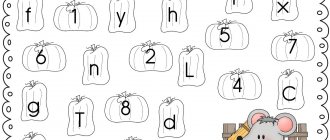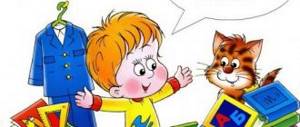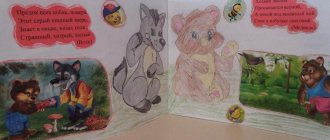Pronunciation check
Parents can check the correct pronunciation of sounds by their child themselves. There are different tests for this. You can use the same technique with which speech therapists evaluate a child’s speech at the first appointment: ask to pronounce words or syllables containing hissing sounds (for example, noise, school, came, bumblebee).
To pronounce W correctly, the tongue should be like a ladle, located in the center of the oral cavity, and not stick out forward. It is important that the tip points upward.
The verification should be carried out in stages:
- The first stage is a general check. You need to ask the child to say a couple of easy sentences that contain words with a letter (for example, “you should wear a scarf in winter,” “the cat caught the mouse”). Next, you need to move on to the pronunciation of individual words (edge, hat, good, porridge);
- the second stage is checking the sound of Ш in isolation. Attention is paid to syllables. You need to ask the baby to say “OSH”, “SHA”, “OSHO”, “USHU”. This will allow you to find out how well the child can pronounce sounds. It happens that such a check reveals problems with vowel sounds. Therefore, it is recommended to vary the syllables;
- the third stage is testing in individual syllables with voiceless and voiced consonants.
To check the pronunciation of different sounds, there are special cards with bright pictures. They are sold in children's stores. Thanks to such cards, the test can be carried out in the form of an enjoyable game.
Staging and subsequent automation of sound
By performing the exercises, they develop the correct articulation of “W”. But a skill is a mechanical process that takes time to practice and consolidate. A child can learn to pronounce “Ш” already in the first lessons, but in subsequent lessons the pronunciation turns into a lisp and whistling.
Speech games and tongue twisters starting with “Ш” will help automate sound:
- I can’t find our frog’s ears.
- Masha walked along the highway and sucked dryers.
Making the sound “Ш” by imitation.
You can come up with an interesting nickname for your favorite toy using “Sh”. For example, “Wolf-tail.”
Nursery rhymes will help you practice your speech.
You can ask your child to come up with a diminutive word. For example: winter - winter, spot - spot, mistress - hostess, uncle - uncle, grandfather - grandfather.
Why doesn't the letter "Ш" hiss?
The reasons for incorrect pronunciation may be the following:
- Physiological: malocclusion, large tongue, high palate. In addition, the quality of the spoken sound depends on the development of the speech apparatus.
- Prolonged use of the pacifier. This item spoils the bite, which leads to distorted pronunciation of whistling and hissing sounds.
- "Lisping" with a child. By repeating after their elders, children distort their speech.
- Repeating incorrect pronunciation after adults who have speech impediments.
- Memory, thinking and attention are poorly developed.
- Speech hearing impairment (in some cases, dyslexia may develop).
If, after homework, the child still cannot pronounce the letter “SH,” you should contact a speech therapist.
Guidelines for parents
Sometimes parents do not turn to a speech therapist for various reasons. Some due to financial difficulties, others in accordance with their beliefs. At the same time, parents should know how to teach their child to say the letter “SH”.
Tips for sound production [Ш]
Learning to pronounce a sound correctly is not so easy and therefore a child needs the support of adults. Every day you need to devote about 20 minutes to the lesson.
Warm up for tongue and lips
The most effective and easy-to-implement way to cope with failure to pronounce sounds is articulatory gymnastics.
It includes the following exercises:
- “Let’s warm our palms.” His goal is to learn how to release a strong stream of air. The child needs to exhale air in even portions with rounded lips, without puffing out his cheeks.
- Naughty tongue. The exercise helps relax the tongue muscles. With the tongue placed on the lower lip, the syllable “five-five-five” is pronounced from 1 to 10, the edges of the tongue do not rise upward.
- Glue on some candy. The result of such training should be strengthened tongue muscles and a practiced upward movement of the tongue. The tip of the tongue is located on the lower lip, a small piece of toffee is placed on the edge, which must be glued to the palate. The jaw should remain motionless, only the tongue works.
- Swing. The tip of the tongue touches either the upper or lower teeth.
- Horse. Clack like a horse.
- Pancake. Place a relaxed tongue on the lower lip.
- Kitty. The child needs to reach his nose with his tongue.
- Focus. You need to open your mouth while smiling and place the edge of your tongue on your upper lip so that a groove is formed in the center; now you need to blow off the cotton wool that lies on your nose.
After warming up and practicing these exercises, you can begin direct sound production.
Exercises for breathing development
- “Kick the ball into the goal”, a game of unusual football. A gate is built in the center of the table and cotton “balls” are made. Players from both sides blow on cotton balls so that they fly into the goal. The adult monitors the child’s correct articulatory actions: a wide smile, tongue on the lower lip.
- "Snowflakes on the nose." Invite the preschooler to blow a cotton ball off his nose using the correct movements of the jaw: a wide smile, tongue on the upper lip, blow so that the ball flies up.
- The games “Blizzard”, “Leaves are Flying”, “Ships”, “Planes” are played in the same way.
Staging exercises from sound C
The most common method of producing the sound Ш from S. This method is used when no impairment of the mobility of the speech apparatus is detected. Even a not loud whistling sound will be useful for staging hissing ones. The child needs to raise his tongue to the roof of his mouth and pronounce S without tension. After that, he needs to release the air when pronouncing. This produces a sizzling Sh.
How to set the sound?
After such games, you can start making the sound [sh]. In speech therapy, exercises for producing a hissing sound come down to “rearranging” the tongue into the desired position when pronouncing the sounds [t] or [s] (sometimes the sound [r], but this process is more complicated, since it will be necessary to stop the vibration of the tongue).
To do this, you can use a regular teaspoon:
- We ask our child to pronounce a long [s];
- at this time, using the handle of a spoon, we gradually push the tongue behind the teeth and give it the shape of a cup;
- when it takes the desired position, [s] will turn into [w];
- We ask the baby to remember where and how his tongue is located.
The same can be done when pronouncing the long sound “T-s-s-s”.
Now have your baby repeat the following exercises. At the same time, show your child pictures that will help the child get ready to do the exercise.
- hisses like a snake;
- like a tire or balloon from which air escapes;
- like the leaves of trees in the wind;
- like an angry cat;
- like autumn leaves underfoot;
- like a mouse scratching in a hole.
To reinforce the resulting sound, it is important to provoke children to pronounce words that contain it as often as possible. Tongue twisters or pure twisters are best suited for these purposes. In them, the necessary sounds are in different positions; children will have to pronounce the sound [w] at the beginning of the word, in the middle, at the end.
This is how the acquired skill is reinforced through the game. If by chance the pronunciation of the phoneme is distorted again, you need to return to exercises with the sounds [s] or [ts].
To automate sound, the simplest exercise is for the child to pronounce alternately the syllables “Ш” and different vowels. Let the child “Jump” with his finger over the bumps and pronounce the syllables.
Hissing sounds are some of the most stubborn sounds to master. Therefore, if at the age of 5 the child has not mastered them even with the help of all the exercises outlined, you need to consult a speech therapist. Otherwise, the problem may develop into a psychological complex and cause poor performance.
Exercises to practice pronunciation
Parents do not always understand how to teach their child to say the letter Ш at home. After setting the sound, they immediately move on to automating it and for this they use direct syllables: SHA, SHO, SHU, SHI.
Then they move on to the reverse syllables: АШ, ОШ, УШ, ИШ.
Important! The child can lay out pebbles, wind threads and jump.
They move on to words and sentences only after it is possible to achieve the correct pronunciation of the sound [Ш] in syllables.
Tongue Twisters
For an introduction to independent speech, it is useful to pronounce tongue twisters during an individual speech therapy lesson on sound automation [Ш].
Tongue twisters start speaking slowly and gradually increase speed
Examination of the pronunciation of the sound “Ш”
When examining pronunciation, a specialist must find out how the sound being tested is pronounced separately, in words, in speech. For this purpose, images whose names include “Ш” can be used. It is important that it occupies different positions and combines with other sounds. The little student is asked to recite a poem in which the words have an "W".
If a child does not clearly pronounce an isolated “Sh”, you must first introduce this sound, and then consolidate its pronunciation in speech. If a child correctly pronounces a separate sound, but the defect is observed only in words, you need to work on consolidating it in speech.
Rules for testing at home:
- The child is in a calm state, repeating the necessary words after one of the parents. When forced into pronunciation, the sound is often distorted.
- The child pronounces the desired sound more than once. Sometimes children, even if they have a defect, can imitate the correct sound and the violation is not immediately noticed. It is easier to hear defective pronunciation in words where “Ш” is pronounced together with other consonants. To check, the child should pronounce the following words: chestnut, muffler, punch, mouthpiece.
For some children, the problem can be overcome in the first lessons; for others, the defect is dealt with step by step over some time, selecting appropriate tasks and techniques.
What to do if the child does not pronounce “w”?
When pronouncing a voiced “zh,” the vocal cords are involved. The exhaled stream and the tension of the tongue during sound are weak. The tip of the tongue trembles and vibrates a little under the influence of the air stream. If the child’s tongue is not mobile enough or is sluggish, then specially selected preparatory exercises are necessary.
The sound “zh” is complex in its articulation, so children master it relatively late and often pronounce it incorrectly or unclearly even by the end of preschool age. There are several options for incorrect pronunciation of this sound: either it is completely missed, or pronounced unclearly, or replaced with another (most often “z”).
Violation of the sound “zh” is in most cases correctable, and often this deficiency is eliminated relatively easily. But an indispensable condition is the regularity, systematicity of the exercises and the desire of the child himself to correct his speech and begin to pronounce “w” correctly.
Before starting classes, you need to check whether the baby’s phonemic hearing is sufficiently developed, that is, whether he can distinguish hissing sounds from other, similar sounds. To test and train phonemic awareness, it is useful to ask the child to come up with words with the sounds in question. Select pictures whose names contain these sounds, and work out with your child the meaning of words that differ in one sound.
Warm up for tongue and lips
To better pronounce sounds, you can use a tongue warm-up, which consists of the following exercises:
- First, we round the lips, the teeth do not close, the edges of the tongue are pressed against the teeth, and the tongue itself forms a scoop. Exhale with added air while making a hissing sound.
- Spread your tongue wide, bend its tip and stick it out with raised side edges.
- Raise the protruding tongue alternately to the upper and lower teeth, to the upper and lower lip.
- “Accordion” to strengthen the muscles of the tongue in a vertical position: open your mouth, smile, and press your tongue to the roof of your mouth, open and close your mouth 5 times.
- “Pie”: open your mouth and smile, curl your tongue, lifting the edges, count to 15, and then repeat.
Face massage
As a separate element, massage is not a special factor, but together with articulatory gymnastics and voice-speech training it has a positive effect on correct speech production.
When doing a massage, we pronounce our movements:
- Gently stroking your eyebrows with your fingers, we say: “This is how we love ourselves, this is how we love ourselves.” Next, stroking along the nose, we say: “Nice little nose, we have such a snub nose.” We massage around the lips, cheeks to ears: “Our smiling mouth, still a talker”
We gently tap the same areas of the face with our fingers. Counter and opposite movements. We constantly communicate with the child: “We are beautiful! We are happy! This is how we caressed ourselves!”
When to see a speech therapist
Distortion and replacement of sounds in three-year-old children is not considered a deviation. But if at 2 years old the child has no speech, then it is worth going to a consultation with a specialist. Only by the age of 5 does the formation of the phonetic series end. The placement of “W” and “F” occurs between the third and fifth years of life.
Impaired pronunciation is correctable and can often be eliminated relatively easily. The main thing is that classes are regular and systematic. It is important that the little student himself has the desire to correct his speech and pronounce “Sh” and “F” correctly.
The child and parents must show patience and perseverance during lessons. If the results are poor, then you should contact a speech therapist. A specialist can place “W” and “Z” from the reference sound with mechanical assistance, using a probe or spatula.
Possible deviations
During the examination, it can be revealed that the sound “Ш” is pronounced incorrectly. Despite the fact that this sound is considered dull, it must be pronounced clearly and cleanly.
Possible deviations:
- The child sticks his tongue out too much between his teeth, resulting in a lisping sound.
- Sigmatism in “Ш” appears when there is strong tension in the deep part of the tongue. Then “W” is replaced by “X”.
- With lateral sigmatism, a “pop” is produced.
- Dental parasigmatism - the tongue rests on the upper incisors. Instead of "W" you get "T".
- With labiodental parasigmatism, “W” sounds like “F”.
- Instead of "SH" sounds "S", this is whistling parasigmatism.
It is important to tell your child how the speech organs should be positioned correctly. Classes should be accompanied by visual analogies and demonstrations.








